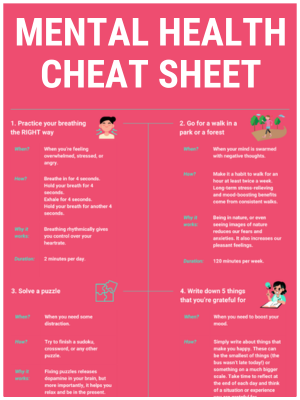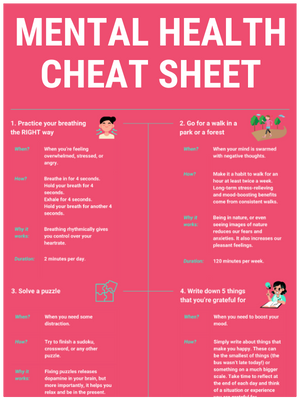Contents
Hello! Who are you?
Hi, my name is Ray Cameron and I live in Colorado Springs, Colorado. I have been married to my wife, Amy, for 32 years and we have three amazing adult children.
I feel most alive when I’m outdoors, especially in the mountains, hiking, backpacking, or fly fishing, all things I’ve been doing since my childhood.
I’ve been in digital marketing since 2007 and most recently served as COO of a marketing agency based in Denver, Colorado. In the next phase of my career, I want to influence employees’ mental well-being by helping businesses build cultures that are supportive of people dealing with mental health challenges.
💡 By the way: Do you find it hard to be happy and in control of your life? It may not be your fault. To help you feel better, we’ve condensed the information of 100’s of articles into a 10-step mental health cheat sheet to help you be more in control. 👇
What is your struggle and when did it start?
Anxiety has been a companion for most of my life and I experienced my first major depressive episode when I was 25 years old. I lived with a diagnosis of anxiety and depression until my late thirties.
After being on and off of anti-depressants throughout those years with underwhelming success, I was diagnosed with bipolar II which was a turning point in the effectiveness of my treatment.
The problem with antidepressants wasn’t that they didn’t alleviate my symptoms but rather that they replaced them with an emotional numbness. I would experience a depressive episode and begin taking an anti-depressant, which would initially increase my symptoms and trigger thoughts of suicide. Eventually, the depression would subside but be replaced with a protective layer of muted emotions which would lead to me going off of the medication. Then with the freedom to experience a range of emotions again, the cycle would start over with another depressive episode.
A close family member who had experienced a very similar pattern told me that they had recently been diagnosed with bipolar disorder and suggested I look into that. I was skeptical because I didn’t consider myself to have experienced mania. I was tempted to write it off but was curious enough to investigate
After visiting my family doctor and sharing this story, he prescribed me a mood stabilizer, which seemed to have a different, more positive effect on me. I experienced some relief from my depression without losing the capacity to feel healthy ranges of joy and sadness.
The manic side of bipolar 2 is officially called hypo-mania and was a mystery to me. My pursuit of understanding led me to see that seasons of hypo-mania seemed to precede my seasons of depression.
My experience of hypo-mania was subtle and disguised as discipline, drive, and passion, all good things except when they were at a level that caused me to live at an unsustainable emotional high. Looking back, I could see the external events that triggered a rapid swing from weeks or months of hypo-mania to debilitating depression.
Increased anxiety almost always existed with my depressive episodes. The combination of those two states paralyzed me and made my bed the only place I wanted to be, leading to the need to take time off of work to recover. Other symptoms included nausea and stomach aches, waking up in the dark and lonely hours of the night, racing thoughts, financial fears, shame, hopelessness, and moments of not wanting to be alive.
I consider my treatment with a mood stabilizer like the inflatable bumpers in a bowling alley. With one side being hypomania and the other side being depression, my medication kept me out of the gutters. I was still able to feel a range of emotions with a lower risk of crisis.
The downside to the mood stabilizer was the loss of what I considered my “friend,” the excitement and productivity of hypo-mania. I missed the buzz and the hidden superpowers. I asked my psychiatrist if I could have just a little bit of my “friend” back. He cautioned me that any give on the hypo-mania side of the alley could have a corresponding risk of going into the gutter of depression.
I accepted that reality and have found a balance that I’m very happy with.
How did this struggle make you feel at your worst moments?
Covered above, I think 🙂
👉 Share your story: Help thousands of people around the world by sharing your own story. We would love to publish your interview and have a positive impact on the world together. Learn more here.
Was there a moment when you started to turn things around?
While getting a correct diagnosis and medical treatment for bipolar II was one turning point in my recovery there was one that was even more significant.
Experiencing more stability eventually led to me feeling like I had figured out what I needed to avoid depressive crises. I thought I was “fixed” and got my hopes up that it was all taken care of and I wouldn’t experience some of the challenges I had before.
When the next depressive episode hit in 2018, I was devastated. How could this happen again when I thought I had it all figured out? I experienced some of the darkest moments of my life and a nearly complete loss of hope. I say “nearly complete” because I had a support system around me that reminded me I had gotten through this before and I could do it again.
Around that same time, a friend of mine shared a story that his dad died by suicide in his sixties. When I heard that, it wasn’t difficult for me to imagine being in the same place someday. That scared me and motivated me to take whatever steps I needed to ensure that wouldn’t be my story.
What steps did you take to overcome your struggle?
My first step was to set up an appointment with my psychiatrist to make whatever adjustments to my medications that were needed. My second step was to find a new therapist knowing that I needed professional help to get on the right track.
I took a close look at everything I was doing and what I had committed to and cleared out whatever I could. That set me up for a season of recovery and doing the work to build my support system and the skills I needed to thrive.
In one of my counseling sessions with Max, he gave me a tool called the Wellness Recovery Action Plan, or WRAP. This tool has transformed my journey with my mental health challenges. Next to my medication, it has become the most important part of my recovery. It’s understandable because it documents all of the tools I need to thrive.
The WRAP is a practical tool, developed under the leadership of Mary Ellen Copeland, PhD. that helped me learn about myself and document things that are important for my recovery and wellness. My WRAP is a 10-page document that I built from a worksheet I found online. You can learn more on the WRAP website.
The core part of WRAP documents four things:
- A daily maintenance plan
- Triggers
- Early warning signs
- When things start to break down
And this is followed by a personal crisis plan.
I don’t want to go through all of the details of WRAP but I do want to share the process and impact it has had on me.
My WRAP journey started with a deep reflection on who I am. What am I like when I’m at my best?
It was difficult for me to do this at the time I was first given the WRAP because I wasn’t in a good place and I had a hard time remembering what it was like to feel good. But this tool helped me reflect on that and notice good things as they started to come back into my life.
When I’m doing well, I’m stable, relaxed, focused, and peaceful. I’m unselfish, which really just means that I’m not obsessively thinking about my own condition. There are seven other words that I wrote down about when I’m doing well.
What do I need to do daily to maintain this level of wellness? There are four things at the top my list that are non-negotiables. If I ever feel like I’m getting off track, I check to make sure I’m getting a good nights’ sleep, eating regularly, drinking water, and taking my medications.
Another one that is important for me is getting outside, in particular, going for a hike. This can be a big challenge for me in the winter when the daylight hours can be as short as nine and a half hours and they coincide with when I’m at work.
There are a total of almost 30 items of activities I can do to help take care of myself, things like backpacking, fly fishing, journaling and practicing kindness to myself.
That’s an example of the types of things that are in the first section of the WRAP. The tool has also helped me recognize triggers that can take me off course like the anniversary of my daughter’s cancer diagnosis, sustained stress levels, major work deadlines, letting someone down, or feeling exposed or embarrassed.
I also have written down things that I can do when I experience various triggers. One of my favorites is that I have a pair of dress shoes that, for some reason, when I wear them, they make me feel important or confident. I call them my “don’t f*** with me shoes,” because they can stir up that kind of attitude on a bad day.
There is so much more to the WRAP but I hope this gives you a sense of what it is and the impact it has had on me. I have several people in my life who have a copy of my WRAP and who have permission to point out things that I might miss. In addition to asking if I’m doing ok, they can point out things they’re seeing that make them concerned for me.
While I’ve never had to use it, there is a crisis plan that instructs others about how to care for me when I am not well, including when to admit me to a hospital and the changes necessary for me to take back control of my own care.
Have you shared any of this with people around you in real life?
Another thing that came out of my crisis in 2018 and my commitment to recovery was being open with people around me, even people at work. I was in a leadership position at the marketing agency I worked at that allowed me to select and present topics for our weekly meetings. I built up the courage to share about my mental health struggles with the 12 employees at the marketing agency and it was the beginning of a transformation of our work culture.
What followed that meeting was a new intentionality amongst the leadership team to be more open about our experiences with mental health. We reviewed our healthcare coverage to make sure that it reflected our commitment to provide resources for our team. We recognized mental health awareness events and each quarter included a mental health topic during our team meetings. I shared my mental health journey with every new employee within their first two days at the agency and made sure they were aware of all the mental health resources.
I began speaking for the local chapter of the National Alliance on Mental Illness (NAMI), telling my story to other businesses and organizations as a way to help them consider how they can help reduce stigma and support people around them who struggle with mental illnesses. I’m also a board member and facilitator for a weekly peer support group.
If you could give a single piece of advice to someone else that struggles, what would that be?
If I could give a single piece of advice to others who deal with mental health struggles I would encourage them to learn more about WRAP, where they can also find a workbook to help them build their own recovery plan. If you’ve done a lot of recovery work already, the WRAP could be a good tool to gather it all in one place.
I also would encourage people to see if there is a NAMI chapter close by. NAMI provides free education and support programs for families and individuals living with mental health conditions.
What have been the most influential books, podcasts, YouTube channels, or other resources for you?
Another tool that has been a significant part of my journey is Acceptance and Commitment Therapy, or ACT, which I was first introduced to through the book, The Happiness Trap: How to Stop Struggling and Start Living: A Guide to ACT, by Russ Harris. Some of the skills I learned from that book and the practice of ACT are contained in my WRAP.
As a business leader, a podcast called The Anxious Acheiver, and a book by the same name, both by Morra Aarons-Mele, have had a significant impact on me and how I think about leading businesses and people.
Where can we go to learn more about you?
The best way to connect with me is to visit my website where you can find links to my social media and other things I’m involved with.
💡 By the way: If you want to start feeling better and more productive, I’ve condensed the information of 100’s of our articles into a 10-step mental health cheat sheet here. 👇
This Cheat Sheet Will Help You Be Happier and More Productive
Thrive under stress and crush your goals with these 10 unique tips for your mental health.
Want more interviews?
Continue reading our inspiring case studies and learn how to overcome mental health struggles in a positive way!
Want to help others with your story? We would love to publish your interview and have a positive impact on the world together. Learn more here.



